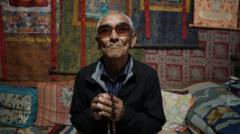Tibetan communities in India, numbering around 70,000, express a deep longing for their homeland and identity, especially against the backdrop of celebrations for the Dalai Lama’s 90th birthday. Many Tibetan exiles, who fled to India following the failed uprising against Chinese rule in 1959, acknowledge the mixed emotions tied to their refugee status. Writer-activist Tenzin Tsundue recalls the stigma of being identified as a refugee during his schooling, reflecting a larger sentiment among exiles who possess renewable registration certificates but are unsure of their place in Indian society.
Dawa Sangbo, an 85-year-old refugee who crossed into India in 1970, shared the trials of his journey and the painful nostalgia for a homeland he can no longer call his own. Full of hope yet heavy-hearted, many exiles articulate their yearning for Tibet, where their families still reside, while they themselves navigate life in a foreign land. Younger generations, born in India, feel a distinct sense of deprivation, raising questions about cultural identity and belonging.
Despite gratitude for the sanctuary India provides, Tibetans face limitations, ranging from restricted rights to difficulties in gaining employment due to their lack of citizenship. While many find pathways to move to Western countries, often pursuing economic stability, some remain tethered by personal ties to Tibet and a desire to reconnect with family.
The mention of the Dalai Lama’s succession plans has stirred discussions about the future of the Tibetan community, with hopes for continuity amidst fears of losing support after his passing. As the Dalai Lama’s health becomes an important global narrative, Tibetans in India continue to advocate for their rights while navigating the intricate relationship with both their received country and their homeland. The enduring question remains: how can they maintain their cultural identity and hopes for a free Tibet in a world shaped by geopolitical dynamics?


















